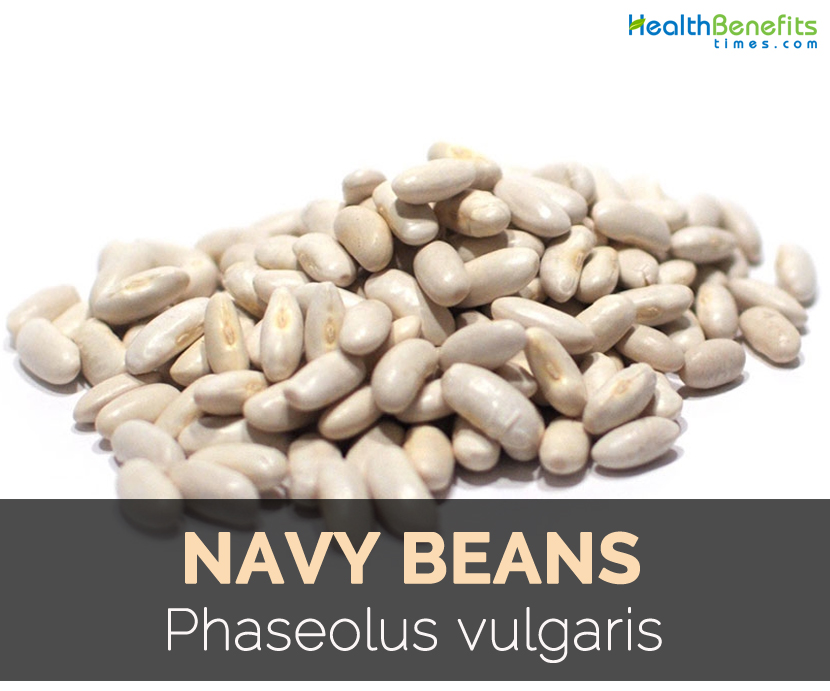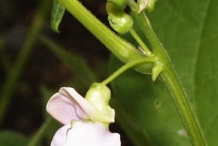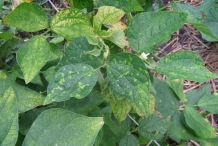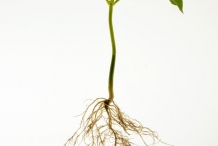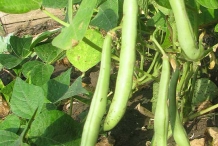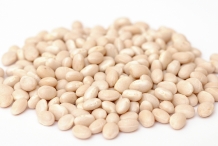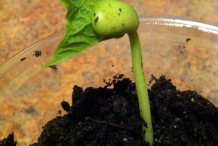| Navy Beans Quick Facts |
| Name: |
Navy Beans |
| Scientific Name: |
Phaseolus vulgaris |
| Colors |
White |
| Shapes |
8-20 cm long, 1-2.5 cm wide, linear-oblong |
| Calories |
255 Kcal./cup |
| Major nutrients |
Vitamin B9 (63.75%)
Iron (53.75%)
Total dietary Fiber (50.26%)
Valine (43.42%)
Copper (42.44%)
|
| Health benefits |
Improve cognition, Healthy heart, Prevent diabetes, Digestive health, Prevent oxidative stress |
Navy beans scientifically known as Phaseolus vulgaris, is a large and annual vegetable that belongs to the family pea and is inherent to South and Central America. Few species are inherent to North America. The beans have trifoliate leaves having ovate to ovate-orbicular leaflets and bilateral symmetrical pea shaped flower that grow in clusters from leaf axils. Later on the flower turn into elongate pods which comprises of seeds and the color of the seeds vary somewhat. Flowers are usually red, pink, yellow or white and pods are yellow, purple or green in color. Other common names for navy beans are Borletti Bean, Climbing Bean, Bush Bean, Common Bean, Dwarf Bean, Dry Bean, French Bean, Flageolet Bean, Field Bean, Garden Bean, Haricot, Green Bean, Haricot Bean, Mange-Tout, Kidney Bean, Navy Bean, Pole Bean, Pea Bean, Popping Bean, Pop Bean, Rose Family Dry Bean and Snap Bean.
History
Navy beans are also referred as common beans and are originated in Peru which was then spread throughout Central and South America with the migration of Indian trades. It was introduced in 15th century in Europe by Spanish explorers that return their voyages to New World. The explorers of Portuguese and Spanish introduced it to Asia and Africa. Being a cheap form of protein, it is widely known in many cultures of world. In the early 20th century, it was a primary food of United States and got its current name. Presently, India, Indonesia, China, United States and Brazil are known as the largest commercial producers of navy beans.
Plant
This herbaceous plant is annual, climbing or sub erect bush which measures about 2-3 m high. Stems are long, pubescent and 2-3 m long. Propagation is done by seed.
Leaves
It has trifoliolate and alternate leaves. It has 4-9 cm long petiole and leaflets of 4-16 cm long, 2.5-11 cm broad which is broadly ovate to ovate to rhombic in shape. Petiolule are 1.5-2.5 mm long and stipules, deltoid are about 2-4 mm long.
Flower
An inflorescence is 1 to 3 flowered. It has ovate and persistent braceteoles. The plant possess bisexual and papilionaceous flower which has cup shaped calyx having tube of 2 to 3 mm long. The corolla are yellow, white, pale pink to purple, glabrous and 9 to 12 mm long. It has obovate wings spirally curved and is about 10 to 12 mm long.
Fruit and seeds
Fruit measures about 1-2.5 cm wide and 8-20 cm long. Fruits are legume of linear to oblong shape in yellow, green, black, white, pink, purple in color. It is slightly curved to broadly undulating with glabrous and turgid beaked. It contains about 4 to 10 seeds of white color. Seeds are kidney shaped, ensiform, oblong of 1-2 × 0.5-1.3 cm size.
Health Benefits of Navy beans
Navy beans have ample amounts of cholesterol lowering fiber in comparison to other beans. Due to high content of fiber, it prevents the chances of increase in blood sugar level which is an ideal choice for insulin resistance, diabetic and hypoglycemia patients. Navy beans if consumed with brown rice provide high quality of protein. The beans is also an excellent source of manganese, folate, vitamin B1, protein along with the minerals such as iron, magnesium, copper and phosphorus.
- Improve cognition
Folate is a vital nutrient that prevents anemia and neural tube defects that affects nervous system. The deficiency of folate is associated with the rise in homocysteine levels that leads to neurodegenerative diseases such as Parkinson’s disease and Alzheimer’s disease. Navy beans have Vitamin B that enhances certain neurotransmitters for enhancement of cognition and memory.
- Healthy heart
Navy beans have folate and magnesium that protects and makes the heart strong. The lower level of homocysteine that leads to heart disease. Magnesium reduces the stress and tension in blood vessels that lowers the blood pressure that helps to prevent from strokes and heart attacks.
- Prevent diabetes
The foods rich in fiber content has great impact on diabetes as it helps to stabilize level of blood sugar and promote the nutrient absorption from gut. The healthy level of insulin and glucose lowers the chances of getting diabetes.
- Digestive health
Navy beans are a great source of fiber that is essential for the maintenance of gastrointestinal health. It add bulk to stool and prevents the chances of diarrhea and constipation. In addition, it normalizes bowel movements with the stimulation of peristaltic motion. The diet rich in fiber cleanses intestines and prevents the chances of getting gastrointestinal problems such as gastric ulcers and colon cancer.
- Prevent oxidative stress
Manganese being the main cofactor of antioxidant enzymes assists in prevention of impact caused by free radicals. It reduces the chances of chronic illness and cancer. It stimulates the flow of blood and joint mobility.
- High protein content
Navy beans have high content of protein that is vital for the growth of new tissues, cells, bones, muscles, blood vessels as well as other parts of body. It is required for the normal development and for the repairment of damaged areas as well as speed up the healing process. It is a great source of protein for vegetarians.
- Circulation of blood
The proper flow of blood is essential for oxygenation of organs and overall function of the body. Iron is a vital component for red blood cells without which the circulation suffers and makes prone to weakness, anemia, fatigue, bone mineral loss and poor circulation. Copper is essential for hemoglobin synthesis. With the requirement of iron, copper is equally essential for making the iron provide its benefits.
- Skin health
It is a great source of copper that acts as antioxidant which is required for the maintenance of healthyd skin. It provides glowing and healthy skin. It should not be consumed raw. Soak these beans for about 8 to 9 hours before cooking because it makes the cooking process faster as well as easier and also assist in digestion process.
- Lose weight
Navy beans are an ideal choice for those who want to lose extra pounds without getting deficiency in major nutrients. It has low content of calories and is fat free. It has various complex carbs that prevents the body from obtaining unnecessary weight.
Recipe of Navy Bean
Here is a look at how to mix navy beans with only a few simple ingredients to make a extremely satisfying, nutrient-dense meal which is free from gluten, dairy, and excess carbs:
1. Lime-Marinated Navy Bean Salad
Ingredients:
- 1 1/2 cups of cooked white beans, drained or rinsed
- 1 large chopped ripe tomato
- Handful chopped green onions
- 2 tsp of minced parsley
- 1/4 cup of fresh lime juice
- Extra-virgin olive oil
- Sea salt
- Fresh figs
- Chopped capers
Directions:
- Put beans with 2 tbsp. of lime juice and 2 tbsp. of extra-virgin olive oil in a large bowl. Add sea salt and mix well. Cover and refrigerate for about one hour.
- Then marinate in lime juice. Add minced parsley, chopped green onions and chopped tomatoes.
- Then add fresh figs and chopped capers then serve.
2. Bean Soup Recipe
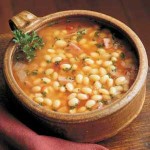
Ingredients:
- 2 cups of Navy beans
- Black pepper
- Salt
- 2 medium onions
- 2 tsp. of paprika
- 1 bell pepper
- 1/3 cup of corn Oil
- 3 stalks of Celery
- ½ can of Tomato paste
- 2 garlic cloves
- 1 tsp. of Tumeric
Directions:
- Soak the beans overnight.
- Then wash beans and chop the vegetables.
- Mix all the vegetables and seasonings. Put enough water so that the beans cove well.
- Cook it on moderate flame until the beans mash easily to touch.
- Add more boiling water if required. Then strain with the use of Foley Food Strainer and serve it with toast and cheese. Add more boiling water if soup is too thick.
3. Navy Bean & Roasted Garlic Soup
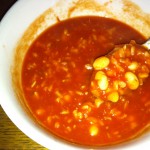
Ingredients:
- 1 pound of dried Navy beans
- 1 tablespoon of olive oil
- 1 medium chopped yellow onion
- 1 chopped celery rib
- 6 cups of water
- 1 head of roasted garlic
- 1 bay leaf
- ½ teaspoon of dried thyme leaves
- Ground black pepper
- 2 tablespoons of chopped fresh parsley
- ¼ cup of chopped fresh basil
Directions:
- Eliminate small rocks or other particles. Then rinse it well to clear all dust.
- Heat a soup in a pot or big saucepan on medium heat. Swirl oil round on the bottom of hot pot. Then add onion and celery and let it stir until the onion is gently browned.
- Add the water, bay leaf, garlic, thyme and beans. Let it boil. Lower heat to make it simmer. Cover the pot and cook till beans become tender for around 2 to 3 hours.
- Mash a cup of beans and put them to pot. Put additional water if necessary. Season with black pepper and eliminate bay leaf. Stir with parsley and basil before serving.
Precautions
- It should not be consumed raw as it contains linamarin which is poisonous if consumed raw. This may lead to multiple organ failure, paralysis or even death. So the beans must be cooked as this linamarin is converted into an edible form and does not provide any threat.
- It contains oxalates which is found in plants and animals. In excessive it could lead to complications. They are accumulated in the body fluids and even form stone like structures. It lowers the ability of body to soak up calcium.
- The individuals which have renal problems or weak urinary systems should avoid navy beans.
How to Eat
- In Papua New Guinea and Southeast Asia, leaves are consumed as vegetable.
- Immature pods are boiled, steamed, stir fried or baked.
- The pods are also mixed with corn, carrots and peas.
- In USA and Britain, it is added to pies, baked beans and soups.
- The young seeds are boiled or cooked as vegetable.
- To make sandwich, blend navy beans with flax oil or olive oil in a food processor along with herbs and spices.
- Serve precooked navy beans with tomato soup.
- Cook the mixture of sage, olive oil, garlic and navy beans and serve it with bruschetta.
- Mix navy beans with healthy sautéed onions and cooked or roasted buckwheat and shiitake mushroom.
- Navy beans could be added to salad of chard and leeks and top it with rosemary vinaigrette.
References:
https://www.itis.gov/servlet/SingleRpt/SingleRpt?search_topic=TSN&search_value=26857#null
http://davesgarden.com/guides/pf/go/397/
https://npgsweb.ars-grin.gov/gringlobal/taxonomydetail.aspx?id=27632
http://www.missouribotanicalgarden.org/PlantFinder/PlantFinderDetails.aspx?taxonid=280470&isprofile=0&pt=1
http://www.floracatalana.net/phaseolus-vulgaris-l-
http://www.whfoods.com/genpage.php?tname=foodspice&dbid=88
http://www.stylecraze.com/articles/amazing-benefits-of-navy-beans-for-skin-hair-and-health/#gref
https://www.organicfacts.net/health-benefits/other/navy-beans.html
Comments
comments


